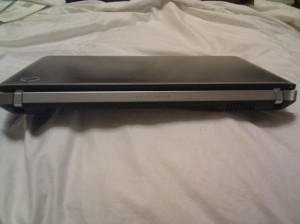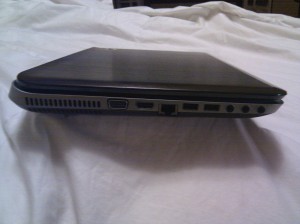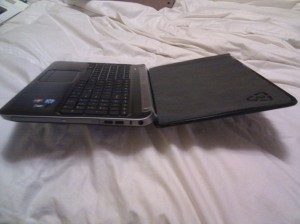My last post, I talked about the physical aspects of the Cr-48 at a first glance. Now that I’ve spent about a day with it, I have a lot to say. Let’s start with the first boot of Chrome OS.
 Turning on the Cr-48 |
 Connects to the internet via Wireless and/or 3G |
 Chrome's Terms of Service agreement |
 Getting the latest Chrome files |
 Sign in with a Google Account or as a Guest |
 Say "cheese"! |
 First time using Chrome screen |
 Pilot Program message |
 Let the games begin! |
…
Well after playing around with it I can safely say it is basically a laptop with the only application being the Goole Chrome Browser. Although there are some differences between Chrome OS and Chrome Browser:
- There are Chrome OS specific apps – so far the only ones I’ve found are Scratchpad and Google Talk.
- The current Flash player on Chrome OS pretty much sucks – it works but the performance of the OS slows down easily and quickly as more Flash applications are running simultaneously. (ie. Pandora, Youtube, some Flash game, etc.)
- Screenshots goto your download folder-probably the only thing stored locally/temporarily on Chrome OS, screenshots.
If I find any more key differences I’ll be sure to update this list… Overall the Chrome OS experience is good and what I expected. The boot time is quick (5 seconds at most?), waking up from sleep is pretty instanetous as well, and I can connect to the web anywhere (it has the ability to connect to a 3G connection). Currently the 3G is only with Verizon, which will definitely change over time.
About that 3G connection…
Google has “thrown in” a free 100MB/month data plan for 2 years. You just have to signup for it (put credit card and billing information) and then you’re good to go. “How nice of them!” some would say, but if you are like me you spend a lot of you time on the internet reading articles, watching videos, IMing, and video chatting. All of that requires a lot of data so this 100MB/month plan won’t be enough. Click here to use Verizon’s Data Usage calculator. Of course you can upgrade this plan for a fee(1 day unlimited data for $10, 1 month 1GB data for $20, 1 month 3GB data for $35, 1 month 5GB data fo $50). …Or you can just use whatever free Wireless connection you can find ^_^.
Being an OS designed for the web, say ‘goodbye’ to your Desktop applications, they don’t work in Chrome OS. But not all is lost; nowadays services are being replicated/moved onto the Web anyways. So you just need to find the Web app version of your favorite Desktop app.
An important function of Chrome OS to know is the Chrome Web Store, where you can get Themes, Extensions, and Apps. These add-ons are available to both the Chrome Browser and Chrome OS. Although some will only work in one and not the other. (Themes and Extension work the same way as they do in Firefox.)
Themes will change the general look of Chrome. Extensions are plugins that enhance your Chrome experience (Ad-blockers, screenshot croppers, etc.).
Apps are a little different. The Apps you’ve “installed” will be displayed on a New Tab window.

Initially you may think that they separate applications that will run on their own… but this is Chrome OS, everything is on the web. In my findings, 99% of these apps are just links to websites that use Flash (web apps). So “installing” an App is basically creating pinned Bookmark on the New Tab screen. I feel these super-inflated Bookmarks defeat the purpose of regular Bookmarks. The only exception I’ve found to Apps are Scratchpad and Google Talk. These two Apps are small popup windows that appear at the bottom right of your screen.

Hopefully Apps will change from being links to websites and become more like Scratchpad and Google Talk.
Another important function of Chrome OS are the keyboard shortcuts. With limited keys on your keyboard and only 1 USB port, knowing the keyboard shortcuts will be most helpful.
 Keyboard shortcuts help window toggled on with Ctrl+Alt+? |
 Holding down Ctrl will display all shortcuts with Ctrl |
 Holding down Alt will display all shortcuts with Alt |
 Holding down Shift will display all shortcuts with Shift |
 Holding down Ctrl+Alt will display all shortcuts with Ctrl+Alt |
 Holding down Ctrl+Shift will display all shortcuts with Ctrl+Shift |
 Holding down Alt+Shift will display all shortcuts with Alt+Shift |
 Holding down Ctrl+Alt+Shift will display all shortcuts with Ctrl+Alt+Shift |
My only complaint is that the keys aren’t rebindable. Of course this is all a work in progress so hopefully that will change. Also if you’ve heard, the Caps Lock button has been replaced with a Search button. The Search button pretty much opens a New Tab window, pretty handy instead of using the Ctrl+T shortcut in my opinion. You can change the Search button to behave as Caps Lock through settings. (Why change it to Caps Lock when you can hold down Shift?)
After taking a good run with the software, here are my thoughts of the hardware:
- low Youtube quality- max quality is 480p, no HD quality available. I’m pretty sure the Cr-48 can handle HD quality so this will probably change in the future.
- no Ethernet port – if you aren’t paying for a data plan and don’t have wireless access, you are pretty screwed. Sure you can do some offline note-jotting with Scratchpad, but really you can’t do anything.
- tough to use Touchpad – I think people would call this a “clickpad”. In short, the touchpad is oversensitive (even when adjusting it in sensitivity to the lowest). Also it’s a little too wide, as wide as the Spacebar button. I rest my hands on my laptop so my hands cover the edges of the touchpad most of the time. For instances, sometimes when I’m typing, it detects the touch of my hands as a click and moves my cursor elsewhere.
- limited Keyboard buttons – you got to know your keyboard shortcuts. some keys are no longer present (Home, End, Insert, Delete, etc.) the keyboard shortcuts are the ABCs of using Chrome OS like a pro
- no easy way to adjust power settings – I want to listen to music but close my Cr-48… but it auto-sleeps whenever I close it. I haven’t found an easy way to adjust this yet.
- no Spinning disk – “it’s quiet… too quiet “. I’ve heard that there’s a SSD inside that houses the OS, which would explain the lack of sound/a spinning disk. Makes sense to use a SSD for Chrome OS as changes to OS files occur only from time-to-time.
- one small fan – I’m sure there’s a fan inside otherwise the Cr-48 would overheat (like all machines). Plus there are air output from the bottom and leftside of the Cr-48. I can’t hear the fan so the only thing I hear is my typing.
Overall I’m quite impressed with this netbook-like laptop. As far as a proof of concept goes, the Cr-48 with Chrome OS passes. In my opinion, this machine is definitely usable for casual internet usage. There’s definitely a more that needs to be done before people will return to buying a machine like this. I feel Chrome OS is designed as a netbook OS, which is fine. But to sum up my thoughts of current netbooks (and I’m sure others can agree) is that netbooks fail (based on things like performance, usability). Maybe Chrome OS will change the netbook paradigm for the better… or maybe it will change the standard laptop market.
I look forward to the future developments of Chrome OS. Until then, I’ll play around in Developer Mode…
























































































